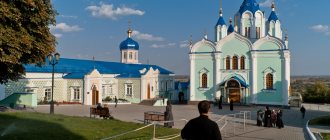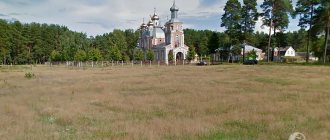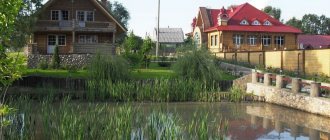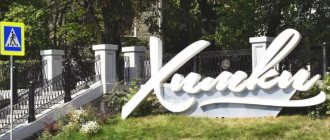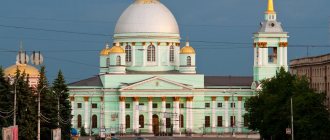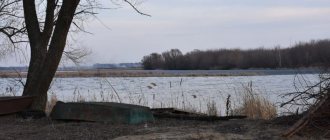TOP 3 - what to see in Skopin in 1 day
The number of attractions in Skopin is dizzying. If a tourist does not have time to visit them all, he should focus on his “tricks” - these places most fully reflect the history and modern life of the city.
Pottery Museum
- Address: st. Lenina, 20.
In the second half of the 19th century, two peasants - the Ovodov brothers - founded a pottery workshop in Skopin. This became the starting point for the development of Skopino ceramics. The Pottery Museum is located in an old brick building - a former merchant estate.
And although the exhibition occupies only two halls, it is very numerous and varied. Here tourists will see ceramic products created one hundred and two hundred years ago. All of them are made in a different manner and using different production methods. In the old days, ceramics were fired in a kiln, but now special equipment has been created for this. Tourists will be able to examine and compare dishes made in ancient times and in our time.
The museum is famous for the Potters Festival, which is held every three years. The festival is attended by masters from different cities of Russia. They share their experiences, teach pottery to beginners, donate their masterpieces to the museum and participate in competitions. The museum has a separate exhibition dedicated to the winners of the Festival.
House of composer A.G. Novikova
- Address: st. Karl Marx, 24.
In 1896, the future Soviet composer Anatoly Grigorievich Novikov was born in Skopin. Throughout his life, he composed more than six hundred songs and set music to poems by famous Russian poets. The most famous works are “Dark-skinned Woman”, “Oh, the Roads...”, “Hymn of the Democratic Youth of the World” and “Vasily Terkin”.
In Skopin, the house in which the composer spent the first years of his life has been preserved. This is a one-story plank manor, attracting attention with its colorful decor. The facade of the building is decorated with carved platbands, panels, as well as stars and flowers made of wood.
On the façade there is a memorial plaque dedicated to the memory of Anatoly Novikov. In the late 1980s, the house housed a children's music school. Later, the institution was provided with a new building, and Novikov’s estate again became residential.
Monument "Eternal Flame"
- Address: st. Poletaeva, 105.
The monument was created in 1995 in honor of the 50th anniversary of Victory in the Great Patriotic War. It is based on three 70-meter arched steles. They are decorated with artistic reliefs depicting the liberation of Skopin from the Nazis.
On the end walls of the side steles there are memorial plaques with the names of Skopino residents who gave their lives for the freedom of their small homeland. During the opening ceremony, an eternal flame was lit at the foot of the steles.
Today, the memorial square is the venue for military-patriotic events, and local steles are recognized as the main historical monument of the city.
Agriculture
Plant growing. The land fund of the Skopinsky district is 172 thousand hectares, of which 149 thousand hectares are agricultural land. 95.7 thousand hectares are assigned to enterprises engaged in the production of agricultural products. Farmland amounts to 88.5 thousand hectares.
Cereals. Among the grain crops grown in the region are wheat, rye, barley, oats, triticale, buckwheat, millet and leguminous crops.
Industrial crops. Of the industrial crops, only sugar beets are grown in the region. Agricultural enterprises and peasant (farm) households abandoned the cultivation of potatoes. Currently, its planting and harvesting is carried out only on private farms of citizens.
Cultural recreation in Skopin: museums and theaters
Tourists should not pass by Skopino theaters, cinemas and museums. These places were created to give guests and residents of the city a lot of impressions and pleasant evenings.
Museum of Local Lore
- Address: st. Karl Marx, 95/18.
At the end of the 19th century, Skopino merchants and teachers created a weapons museum. This exhibition existed until 1917. After the revolution, the museum was almost completely destroyed, but some valuable guns were preserved. In 1919, historian and local historian V.A. arrived in Skopin. Sushitsky, who revived the museum and gave it the name “Museum of the Local Region”.
Today the museum is located in the former estate of the merchant Vlasov. This two-story red brick building in the classicist style was built in the mid-19th century. The exhibition occupies 12 halls. The most interesting of them are:
The Streletsky Hall is an echo of the original Museum of Weapons. This hall provides an opportunity to trace the evolution of weapons, from the Neolithic era to the 19th century. Tourists will see ancient arrows and bone knives, medieval chain mail, arquebuses, guns and cannons, as well as a treasure of copper coins discovered in the vicinity of Skopin in the 1960s.
"Hall of Archeology and Antiquity." The exhibition tells about the first inhabitants of the Skopinsky district. Among the exhibits you can see the skull of a woolly rhinoceros, the teeth and tusks of a mammoth, as well as the fossilized remains of prehistoric mollusks.
“The Hall of Skopin’s Life in the 19th-20th Centuries.” This room recreates the atmosphere of a peasant’s hut who lived at the turn of the 19th and 20th centuries.
"Merchant's living room." Before the revolution, many merchant families lived in Skopin. Their estates still decorate the streets of the city, and the interiors can be viewed in this section of the museum.
"Skopin's Pottery Tale." The exhibits in this room are ceramic products and devices for their creation. The highlight of the exhibition is a pottery wheel donated to the museum by the city’s oldest potter M.M. Pelenkin.
"Railway and Mine". The hall is dedicated to the history of the development of railways and mining in the Skopinsky region, as well as the military exploits of railway workers and the heroism of miners shown in the line of duty.
"Hall of Education and Culture." In this hall, tourists will get acquainted with the history of the construction of educational institutions, the development of book printing, and will also learn interesting facts from the biographies of creative personalities and famous scientists who were raised by the Skopinsky land.
"Hall of Military Glory". This exhibition presents a condensed history of the capture and liberation of the city during the Great Patriotic War. Much attention is paid here to the exploits of thirty Heroes of the Soviet Union who were natives of Skopin.
In addition to the permanent exhibition, the museum regularly hosts thematic exhibitions, competitions, master classes and cultural events.
Palace of Culture named after V.I. Lenin
- Address: Lenin Square, 1.
Lenin Square is one of the most beautiful places in the city. It is decorated with snow-white sculptures and flowering flower beds, but its main asset is the Palace of Culture - a magnificent building in the classicist style, decorated with a massive portico with a colonnade.
The Palace of Culture regularly hosts concerts of creative groups and folk ensembles. Live music concerts and exhibitions of paintings, caricatures and photographs by Skopin artists and photographers are very popular.
In the future, a “Coworking” zone will be opened at the Palace of Culture - this is a small area for relaxation and work with free Wi-Fi and a nearby cafe. Here you can while away the time before a performance or a break between lectures, which are often held at the Palace of Culture.
Youth Theater "Limit"
- Address: Lenin Square, 1.
The youth theater was created in 1988 on the basis of the “Theater of Young Spectators”, which has existed in Skopin since the 1950s. “The Limit” is the pride of not only the city, but also the entire Skopinsky district. Its artists are young men and women full of energy and enthusiasm, as well as professional actors who help young people discover their talents.
The theater works in the author's direction, which is based on the thoughts, feelings and experiences of a particular person. Visitors to the theater do not skimp on their praise and call it the best in the whole country. This impression, without a doubt, is made by the atmosphere of spirituality and ardent love for art that reigns here.
Center for Folk Arts and Crafts
- Address: st. Lenina, 20.
The center has been operating since 2014. The Museum of Pottery is opened at its base. The craft center attracts tourists with an exciting program that aims to transfer traditional skills to a new generation.
The Center runs pottery classes and also hosts master classes for children and adults. The events are held by local craftsmen who teach children how to make whistles and toys, and adults how to use a pottery wheel.
Pottery is Skopin's main craft, but not the only one. The Center also develops such crafts as Mikhailovsky lace, Shilovsky vine and Kadomsky veniz.
By coming to the master classes, tourists will get acquainted with all the crafts, see many amazing products and learn the traditions and secrets that their ancestors passed on to modern craftsmen.
Cinema "Skopin"
- Address: Lenin Square, 1.
In 2021, a modern 3D cinema hall appeared in Skopin, which quickly became the most popular place for entertaining children and youth. Skopina has everything you need to watch movies comfortably: comfortable chairs, a huge screen, high-quality sound equipment, popcorn and drinks.
Cinema employees actively maintain a website and social networks, where they post videos with reviews of films left by viewers. This helps visitors make a choice regarding the film.
Climate, minerals, water resources, soils, forests
The climate of the region is moderate - continental, with moderately warm, often dry summers, moderately cold winters, short springs and cloudy, often rainy autumns with clearly defined seasons.
The predominant winds in spring and winter are southwestern winds, in summer – western and northwestern.
Minerals. The region has reserves of loams and clays for making bricks, loams and clays for the production of expanded clay, construction sands for the preparation of mortars and the production of silicate bricks.
Deposits of peat, coal and gypsum have been explored and exploited in the region. In the Skopinsky district there is also the Lopatinskoye medicinal peat deposit, located north-west of the city of Skopin, near the village. Lopatino. Peat is low-mineralized, low-sulfide, high-ash. Deposits of brown coal have also been explored.
There are mineral waters in the area - low-mineralized sulfate, drinking and medicinal-table waters.
Water resources. The rivers of the region belong to the basins of the Don and Oka rivers. In the western part of the region, rivers flow mainly from east to west, and in the eastern part - in a westerly direction.
Among the large reservoirs in the area there are the rivers Ranova, Verda, Pitomsha, Stary Kelets. In addition, there are small rivers and artificial reservoirs (ponds). The rivers are constantly fed by the release of groundwater in the form of springs along the bottom of the gullies and hollows that gravitate towards the rivers. The rivers are lowland rivers, the common feature of which is the presence of a flooded floodplain area, tortuosity, a slight fall and, as a consequence, a slow flow.
There are no large lakes in the area.
Soils. The region's territory is predominantly dominated by leached clayey and loamy chernozems. A significant territory is also occupied by forest dark gray and gray forest soils of clay and loamy mechanical composition. There are also areas of highly leached and podzolized chernozems and floodplain lands with loamy and clayey soils along the Ranova and Verda rivers.
Chernozems are common in the western part of the region. They are well humified, saturated with bases, provided with plant nutrients, and have favorable water-physical properties. Gray and forest dark gray soils, common in the eastern part of the region, are slightly less fertile. When used in agriculture, they require the application of mineral and organic fertilizers. Soil and climatic conditions are favorable for agricultural production.
Forests. Skopinsky district is located in the forest-steppe zone. There are few forests here, most of the territory is plowed. Small and few islands of forests have been preserved along ravines and ravines, the largest of which are located in the eastern part of the region. Oak forests are the predominant indigenous forest type. In the forests of the region, “secondary” species are common - birch and aspen forests. Linden, ash, maple, and elm also grow well. Hazel, rowan, wild rose, bird cherry, viburnum and other plants grow in the undergrowth of deciduous forests and oak forests.
The role of the region's forests in supplying enterprises with wood is secondary, since small forest areas perform mainly medium-protective, recreational and sanitary-hygienic functions.
Ancient architecture of the city of Skopin
In the Museum of Local Lore, tourists often linger near old photographs of Skopinsky landscapes. They depict merchant estates, schools and other ancient buildings. Many of them decorate the city to this day, and seeing them in person is much more interesting than in photographs.
Railway station building
- Address: st. Lenina, 125G.
The railway station was built at the turn of the 19th and 20th centuries. This is a stone building in the classicist style. The central massif is topped with a pediment and decorated with massive columns with molded capitals.
The station and the adjacent square are historical places of the city. During the Great Patriotic War, conscripts departed for the front from here, and meetings with returning heroes full of joyful tears took place here.
In front of the station there is a monument dedicated to the liberators of the city from the Nazis. It is an irregularly shaped white stone stele with a carved five-pointed star and a memorial inscription.
The monument occupies a small niche framed by columns. In addition, memorial plaques dedicated to the events of the Great Patriotic War are installed on the facade of the building.
Former Real College
- Address: Proletarskaya st., 10.
Skopinsky real school is one of the oldest in the Ryazan region. It was founded in 1876 on the initiative of I. G. Rykov, a commercial figure and philanthropist who invested huge amounts of money in the development of the city. Rykov twice submitted a petition to create a school and, in the end, received permission.
Construction of the building began in December 1874. Significant contributions were made by the famous illustrator P.M. Boklevsky. The grand opening of the school took place on September 12, 1876, and classes began on the 15th.
In 1917, the school was transformed into a labor school; during the Great Patriotic War, a hospital was located here, and students of Skopino schools staged impromptu concerts to raise the spirits and morale of the soldiers.
In the post-war years, the school taught such professions as hairdresser, librarian, salesman, and later a pedagogical faculty appeared. Currently, the building houses secondary school No. 1.
For more than 100 years of existence, the school has practically not changed its appearance. The corner building is decorated with an elegant gable with half-columns and a patterned frame. The sharp top is decorated with a figured drum with a miniature dome. This building is called the most sophisticated and unforgettable in the city.
Don't miss: Sights of the Ryazan region
Theological school
- Address: Oktyabrskaya st., 26.
The elementary theological school was created in 1816. The school complex included two-story brick buildings, built specially or purchased from nobles and merchants. The school operated until 1918, after which it was abolished.
The buildings housed Soviet technical schools, a pedagogical school, a medical school and others. In 1941, an evacuation hospital was located in one of the buildings. In the early 2000s, the buildings were returned to the Orthodox Church. Today they are all undergoing restoration.
Skopinsky Bank
- Address: Lenin Square, 15.
Ivan Gavrilovich Rykov made a huge contribution to the development of Skopin, but his descendants remembered him not as a philanthropist, but as a major swindler. In 1863, 32-year-old Rykov took the post of director of the Skopino bank.
Five years later, fifty-four thousand rubles were discovered missing from the bank—a huge amount of money in those days. Rykov, wanting to hide the deficit, created a false balance sheet. He made it as favorable as possible, which attracted potential investors.
The bank began to prosper. To disguise his scam, Ivan Gavrilovich recorded fictitious banking transactions in the accounting books, for example, bills of exchange, loans, shares and interest-bearing securities that did not exist at all.
The scam resulted in 19 defrauded investors who did not live in Skopin. Three wealthy Skopinos managed to expose the fraudster: Leonov, Popov and Ryauzov. The city administration did not believe their words, and the three men had to act on their own.
They turned to the newspaper “Russian Courier”, began sending letters and achieved that they were listened to in St. Petersburg. A scandal broke out. An audit was carried out at the Skopino bank, as a result of which the auditors missed 13 million rubles. The bank went bankrupt. Ivan Rykov was exiled to Siberia, where he lived until his death in 1897.
Today, this history is reminiscent of an old brick building with rustication, stucco inserts and beautiful pediments - this is the same building where centuries ago the cunning Rykov staged the greatest financial fraud of the Skopinsky district.
Former pharmacy building
- Address: Lenin street, 15.
One of the most attractive buildings in Skopin is the first city pharmacy. This is a two-story building in the eclectic style, dating from the second half of the 19th century. The building is painted sea green.
Whitewashed decorative elements give it an elegant look. The private pharmacy operated until 1918. Later, the building housed various Soviet institutions, and today it is occupied by a children's choreographic school.
Skopino temples, monasteries and churches
Pilgrimage tourism in Skopin is developing thanks to numerous churches, ancient monasteries and holy springs, to which tourists come for healing.
St. Demetrius Monastery
- Address: Skopinsky district, village of Dmitrievo.
One of the main shrines of the Skopinsky district is located in the village of Dmitrievo. The exact date of foundation of the monastery and the name of the founder remain unknown. There are several legends about this.
One of them says that the monastery was founded by the hermit Dmitry of Thessaloniki, cutting down a chapel on this site in the 4th century. The second legend dates back to the reign of Dmitry Donskoy, as if the monk Alexander Peresvet prayed here for the prince’s victory in the battle against Khan Mamai. According to the third legend, the monastery was founded by Dmitry Donskoy himself.
Initially, the complex consisted of wooden structures, which were completely replaced by stone ones by the middle of the 18th century. Construction work was carried out at the expense of Skopino merchants. At the beginning of the 19th century, a large-scale restoration was carried out on the territory of the monastery, which was completed in 1854.
As a result of the restoration, the ancient buildings acquired a fresh look, the paintings in the churches were restored and new frescoes were created. A little later, the temple was rebuilt in honor of the Icon of the Mother of God “Joy of All Who Sorrow.” A brick refectory and a three-tier bell tower were added to it.
In 1918, the monastery was nationalized. All buildings became the property of the collective farm. Temples and cells began to be used as warehouses, pigsties and schools. Of the church utensils, only those items that were transferred to the museum survived.
Among them is the apple tree staff of Peresvet, which was kept in the monastery for more than 600 years. After the reorganization of the collective farm, most of the buildings were dismantled into bricks. Only ruins remained of the ancient monastery, and in 1995, when the shrine was returned to the Russian Orthodox Church, restoration was declared impossible.
Currently, new churches have been built on the territory of the monastery. The main one is consecrated in honor of Dmitry Solunsky. This is a cubic building made of brick in an eclectic style.
The architectural ensemble also includes brick cells, outbuildings, a massive wall and a free-standing bell tower, similar in style to the St. Demetrius Church. At its foot is the entrance to the monastery. Next to the monastery there is a church cemetery.
After the restoration of the temples, new shrines were brought to the monastery: pieces of the relics of Sergius of Radonezh, the Elders of Optina and Theophan the Recluse.
Church of St. Nicholas the Wonderworker
- Address: Nikolskoe Cemetery.
The cemetery church was erected in 1872 as a monument to the untimely death of Tsarevich Nikolai Alexandrovich Romanov. The temple operated until 1929, after which it was closed, and a cultural institution settled in it. After the collapse of the Soviet Union, the building was returned to believers in good condition.
The ancient church is made of brick in the neo-Gothic style. The facade is decorated with gables, figured semi-columns and friezes. The composition ends with a tall six with a golden dome.
Cathedral of the Presentation of the Lord
- Address: Poletaeva street.
Sretensky Cathedral is one of the oldest churches in Skopin. It was built in 1779 in Baroque style. The architectural composition consists of a cubic temple with an adjacent apse, a refectory and a two-tier bell tower. In the era of prosperity, the Sretensky Church amazed with its beauty.
The building shone with whiteness, it was decorated with figured columns, stucco moldings, patterned platbands and magnificent paintings. All this luxury was destroyed when the temple was destroyed by the Bolsheviks. The building was abandoned for many decades, and only in 2014 restoration work began here. Despite the fact that the restoration is not completed, services are held in the temple.
Church of St. George the Victorious
- Address: Stekolny Lane, Novikovo.
In the village of Novikovo there is a wonderful example of temple architecture of the first half of the 19th century. The Church of St. George the Victorious was built of brick in the classicism style. It is a quadrangle with a rotunda, arched windows and side porticoes. The refectory is connected to a two-tier bell tower, which ends with a high spire.
In the 1930s, St. George's Church was closed and abandoned. The building fell into disrepair, but in the early 1990s it was completely restored. Currently, St. George's Church is the decoration of the village, just as it was two hundred years ago.
Church of the Assumption of the Blessed Virgin Mary
- Address: Skopinsky district, Uspenskoye village.
The Assumption Church is located in the village of the same name near Skopin. The settlement was founded in the 1990s, and a church appeared in 2004. This is a small beautiful building in a tent style.
The one-story church is crowned with a massive shesterik with a tent and five domes. An apse adjoins the building on one side and a low bell tower on the other.
Spring "Forgiven Well"
- Address: Pavlova street.
The Forgiven Well is one of the oldest and most revered shrines of Skopin. The history of the source is intertwined with many legends.
One of them talks about the robber Bulat, a cruel chieftain who always had little blood. The only consolation of his callous heart was his daughter Forgiven. One day Bulat’s friend Kosog saw the girl and fell in love with her. Kosog sent matchmakers, but the chieftain, instead of answering, showed a sharp knife. Kosog did not give up. Gradually, he lured Bulat’s allies to his side, kidnapped Forgiveness and took him to his city.
Bulat followed them, deciding to kill both traitors. Noticing her father, Forgiven threw herself off the edge of the ravine so as not to see how her lover’s life was taken. The next morning, residents of the town discovered the bodies of Bulat and Kosog, who had stabbed each other to death. Forgiven's body was never found, but in the place where she should have fallen, a crystal stream broke through the ground.
For a long time, the area of the spring was wild, but in the 1920s the first chapel was erected above it. In the 1930s, construction of a water pipeline began in the city, but residents still came to the spring for clean, cold water.
Today the Forgiven Well is marked by a small stone arch with a crucifix and a dome. The forest is rustling around, and on one of the trees there is an icon of the Mother of God.
Administrative division
The territory of a municipality includes the territories of municipalities granted the status of urban settlements :
1. Paveletsk urban settlement (the administrative center is the working settlement of Pavelets). The Paveletsk urban settlement of the Skopinsky municipal district includes 11 settlements: the working village of Pavelets, the villages of Yuzhny, Krasnaya Derevnya, the villages of Kremlevo, Mshanka, Pavelets - 2 stations, the villages of Kremlevo, Vyazovenka, Delekhovo, Khvoroshchevka, Pavelets.
2. Pobedinskoye urban settlement (administrative center - workers' settlement Pobedinka). The Pobedinskoye urban settlement of the Skopinsky municipal district includes 9 settlements: the working village of Pobedinka, the villages of Bolshak, Otrada, Poplevinsky, the villages of Pobednoye, Sekirino, Chulkovo, the villages of Podmakaryevo, Kochugurki.
The territory of a municipality includes the territories of municipalities granted the status of rural settlements :
- Voslebovo rural settlement (administrative center - the village of Voslebovo). The Voslebovo rural settlement of the Skopinsky municipal district includes 11 settlements: the villages of Voslebovo, Verderevo, Kushunovo, Novoe, the village of Lesnichestvo, the village of Briketnaya station, the villages of Vozdvizhenka, Dmitrievsky Khutor, Letovo, Savilovka, Svistovka.
- Gorlovskoye rural settlement (administrative center - the village of Gorlovo). The Gorlovskoye rural settlement of the Skopinsky municipal district includes 21 settlements: the villages of Gorlovo, Novo - Aleksandrovo, Dmitrievo, Rudinka, Trinity - Orlovka, Almazovo, Bogoslovo, Nyukhovets, Petrushino, Zatvornoe, Muravlyanka, Nagishi, Klekotki, Katino, the village of Krasny May, the village of Katino station, the villages of Surovtsy, Pisarevo, Lvovka, Kupchaya, Izmailovka.
— Ilyinskoye rural settlement (administrative center is the village of Ilyinka). The Ilyinsky rural settlement of the Skopinsky municipal district includes 8 settlements: the villages of Ilyinka, Vysokoye, Kazinka, Bereznyagi, Lazinka, Mshanka, the village of Shirokiy, the village of Lazinka station.
— Kornevskoye rural settlement (administrative center is the village of Kornevoye). The Kornevskoye rural settlement of the Skopinsky municipal district includes 8 settlements: the villages of Kornevoye, New Keltsy, Knyazevo, Petrushino, Pupki, the villages of the Rest House, Osinovo-Shilovo, and the village of Velemya.
- Polyany rural settlement (administrative center - the village of Polyany). The Polyanskoye rural settlement of the Skopinsky municipal district includes 5 settlements: the villages of Polyany, Ermolovo, Dmitrievo, the villages of Periki, Svinushki.
— Uspenskoye rural settlement (administrative center is the village of Uspenskoye). The Uspenskoye rural settlement of the Skopinsky municipal district includes 21 settlements: the villages of Uspenskoye, Nemerovo, Lopatino, Gremyachka, Rozhdestveno, Nikolo - Skopin, Mokhovoye, the villages of Dozorovka, Moskovsky, Pokrovsky, Rudinka, Svoboda, Smekalovka, Sovetsky, Krasny, the village of Voslebovo station , villages of Demenshino, Ryumki, Galino, Grivtsy, Voronovka.
— Shelemishevskoe rural settlement (administrative center is the village of Shelemishevo). The Shelemishevskoye rural settlement of the Skopinsky municipal district includes 34 settlements: the villages of Shelemishevo, Borovoe, Gorodetskoye, Dymovo-Volkonskoye, Dymovo-Gosudarstvennoye, Kostemerevo, Novobarakovo, the villages of Polyanskie Vyselki, the central branch of the Zheltukhinsky state farm, the villages of the Zheltukhino, Govorovo stations, villages Gudovka, Zhuravlikha, Konyukhovo, Moskovka, Naumovo, Ulanovo, Urakovo, Bolshaya Kosyrevka, Govorovo, Gorelovka, Gusilovka, Degtyarka, Dubrovschina, Zheltukhino, Ivankovo, Klyucherevka, Kozlovka, Kondaurovka, Kuzminka 2, Leninka, Shelemishevskie Khutora, Petrovka, Ranovka.
Historical memorials in Skopin
Monuments to Skopin are dedicated to historical events of the city and the country as a whole, as well as great personalities who left their mark in the memory of grateful descendants.
Memorial Park "Alley of Potters"
- Address: Park of Culture and Leisure.
In 2015, the “Alley of Potters” was created in the Park of Culture and Recreation. It is dedicated to outstanding artisans who glorified their hometown with their talent. The alley consists of steles with photographs of Skopino potters.
Each of them is a laureate of state awards in the field of art, and some were even awarded the title “People’s Artist of Russia.” Currently, the alley includes seven monuments.
Monument to potter D. Kireev (Skopinsky potters)
- Address: Goncharnaya Square.
Demka Kireev is the first potter mentioned in the Skopin Chronicles, and, therefore, the founder of the main city craft. A monument to him was erected in 2013. The bronze statue depicts Kireev in peasant attire with a clay jug in his hands. The master examines his creation, evaluating it. The monument is dedicated not only to Demka Kireev, but also to all his followers.
Bust of S.S. Biryuzova
- Address: Sovetskaya street.
Sergei Semyonovich Biryuzov is the commander of strategic missile forces, awarded the title of Hero of the Soviet Union. He was born and raised in Skopin, and his fellow countrymen carefully preserve his memory. In the 1960s, a bronze bust of the hero was installed in Skopin.
Together with the pedestal, the height of the monument is three meters. The area around it is equipped with four lamp posts, making the monument look impressive at night. Celebrations dedicated to the Great Patriotic War are regularly held here.
Tomb of the Unknown Soldier
- Address: Nikolskoe Cemetery.
The memorial complex is located in the city cemetery. It includes three monuments:
- a sculptural group depicting two soldiers laying a wreath on the grave of a colleague;
- bronze sculptures of a woman and child who came to the grave of their husband and father. The foot of the monument is occupied by mourning black slabs with the names of Skopintsy who fell at the front.
- a stone stele with a request to descendants to preserve the memory of the fallen heroes.
The monuments are located in a separate square where rallies are held annually.
Stele to the Executed Skopinites
- Address: Oktyabrskaya st., 44.
In 1941, the Nazis occupied Skopin for three days. During this time they shot 26 civilians. Any little thing could serve as a reason for execution: the smell of gunpowder, an empty cartridge found in a pocket. The Nazis held several people hostage in case the partisans killed at least one of the invaders.
Today, a brick stele is installed at the site of the execution. All 26 names of the innocently executed Skopino residents are engraved on the memorial plate.
Stele of Memory
- Coordinates on the map: 53.807688, 39.570745.
In 1995, in honor of the 50th anniversary of the Victory, a stone stele was installed at the Skopin anti-tank line. It was from this line that the defense of the city began in 1941. The front side of the stele is decorated with slabs with historical information, a map of the border, a bas-relief of a naked sword and the coat of arms of Skopin.
Monument to Soldiers who died in local conflicts
- Address: Karl Marx street.
The monument to soldiers who died in Afghanistan and Chechnya is a stone massif with a carved high relief of a soldier. It was installed in 2012.
Hundreds of Skopin residents gathered for the opening ceremony, among whom were veterans of the Afghan war, as well as relatives of fallen heroes. On the pedestal you can read the names of men who did not return from hot spots.
Stele to the liquidators of the Chernobyl disaster
- Address: crossroads st. Poletaeva/st. Lenin.
In May 2008, the grand opening of a monument in honor of the liquidators of the Chernobyl disaster took place in Skopin. The opening ceremony was attended by the head of the city A.V. Posalin, as well as the Skopin residents who took part in the liquidation of the accident.
The stele is lined with white marble, and on its top there is a black block of granite, which symbolizes the ruins of Chernobyl.
Industry
The number of industrial enterprises in 2012 was 8 units. Almost all production in the region falls on the share of production of vehicles and equipment.
The largest enterprises in the region:
• JSC "Skopinsky Automotive Aggregate Plant"
Address: 391843, Ryazan region, Skopinsky district, village. Chulkovo.
Tel: (49156) 5-30-21.
Fax: (49156) 5-30-00
Year of creation: 1962.
The company is a leading manufacturer of struts, shock absorbers and gas springs in Russia. It is an exclusive supplier to the leading car assembly lines in Russia: JSC AVTOVAZ, GM-AVTOVAZ, GAZ, UAZ, IzhAvto, and shock absorbers for GAZ, VAZ, Moskvich cars. In 2012, new equipment was purchased and introduced, and the production of new products for the LADA GRANTA car was mastered.
• LLC Skopinsky Sand-Sand Brick Plant
Address: 391846, Ryazan region, Skopinsky district, Oktyabrsky village.
Tel.: (49156) 74-4-44.
The company produces sand-lime brick.
• RZSM Stroymash - Center LLC
Address: 391844, Ryazan region, Skopinsky district, r.p. Pobedinka.
Tel..
The main types of products are concrete pumps, cast iron, spare parts, saw chains.
• LLC Skopinsky Meat Processing Plant
Address: 391800, Ryazan region, Skopinsky district, village. Uspenskoe, st. Michurina, 1.
Tel.: (49156) 2-08-29.
A food industry enterprise that produces meat products, semi-finished meat products, canned meat and vegetable meat. In 2012, the assortment was replenished with new types of products: poultry carpaccio, lard, chicken kebab on the bone, chicken roll “Prazdnichny”, and Doctor’s sausages. A pancake line and a high-performance twisting and length-portioning device for sausages and frying sausages were purchased. SMPC LLC annually takes part in various exhibitions and fairs, both at the regional, federal and international levels: “ProdExpo”, “World Food”, “Golden Autumn”, “The Whole World of Food”
• Lina LLC
Address: 391800, Ryazan region, Skopinsky district, village. Vertree.
Tel.: (49156) 7-14-43.
Food industry enterprise, production of semi-finished products - frozen pancakes.
The products are widely represented in stores of various formats, such as Auchan, Globus, Perekrestok, Karusel, Dixie, Pyaterochka, STAR, and are also exported to Ukraine, Belarus, and Kazakhstan. In 2012, the company took part in the following exhibitions: “ProdExpo”, “World FoodMoskow 2012”, “Peter FooD”.
• JSC "Skopinfarm"
Address: 391800, Ryazan region, Skopinsky district, Uspenskoye village.
Tel.: (49156) 5-04-36, 5-04-34
Packaging of medicines.
In 2012, new equipment was purchased for the production and storage of finished products.
• LLC "ANP - Skopinskaya Niva"
Address: 391844, Ryazan region, Skopinsky district, r.p. Pobedinka, st. Sovetskaya, 1
Tel.: (49156) 2-08-12
Type of activity: crop farming, livestock farming
• OP “Wagon Repair Depot Pavelets” LLC “Dalvagonoremont”
Address: 391800, Ryazan region, Skopinsky district, Pavelets village
Tel.: (49156) 6-22-22
In 2012, new equipment was purchased for the purpose of re-equipment and modernization.
• LLC "MOSBASUGOL"
Address: 391844, Ryazan region, Skopinsky district, r.p. Pobedinka, st. Factory
Active recreation in Skopin and its surroundings
Fans of sports entertainment will not be disappointed. In Skopin there are a lot of different areas for active recreation.
Motor track
- GPS coordinates: 53.792483, 39.588030.
In 1957, the first Skopino motorcycle track was created on the basis of the Palace of Pioneers. In the 1960s, the same track appeared in the village of Uspenskoye, and in the 1990s, motocross took over the village of Ivanovka.
Competitions are held every summer. Anyone can visit them, but to participate you must register in advance.
Every year motocross takes place on a new route, taking over one of the tracks or combining them. Often competitions are dedicated to the memory of Heroes of the Soviet Union, including Sergei Biryuzov, and other celebrities of the Skopinsky region.
Starobugrovo Pond
Photo: © https://yandex.ua/maps/-/CCUizEUvxC
- Coordinates: 53.813916, 39.564320.
Starobugrovo pond is located within the city. This is a wonderful relaxation area for children and adults. The shore of the pond is covered with tender grass, and shady trees grow nearby.
For children there is a playground with a sandbox, slides and carousels. While relaxing on the pond, tourists swim, light fires, fish and go boating.
Hockey field
- Address: s. Uspenskoye, Skopinsky district.
In 2021, a new open-air hockey rink appeared in Skopin. Local hockey players immediately appreciated its spaciousness, quality of ice and modern lighting.
Skopinskaya hockey rink is the best in the area. Hockey players from Uspensky, Ivanovka and other settlements come here to play. Thanks to this, it became possible to organize competitions between rural and urban teams.
Sports complex "Start"
- Address: Vysokovoltnaya st., 9.
During free time from training, a large swimming pool equipped with five lanes is open to the public at the Start sports complex. The infrastructure includes showers, a locker room, and a sauna (men's and women's).
In addition to the swimming pool, tourists visit a fitness club, a multifunctional games room, a gym, and a table tennis room.
Be sure to see the sights of other cities of the Ryazan region - Ryazan, Gus-Zhelezny, Kasimov and Spas-Klepikov
Skopin is a small town, but it has more than enough attractions. It is impossible to visit all the places in one trip, so tourists will have a reason to come back here again, and they will certainly want to do so.
History of the coat of arms
The coat of arms of the municipal formation - Skopinsky municipal district was approved at a meeting of the Skopinsky District Duma by decision No. 129 of December 2, 1997 and registered in the State Heraldry, registration No. 227.
Description of the coat of arms: in a purple field - a silver osprey flying to the right, carrying in its paws three golden ears of corn and a silver hammer; in the golden free part with a rounded corner there is an old green princely hat with a black sable edge, above which there is a gold decoration (“town”) with a purple semi-precious stone.
